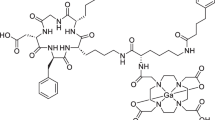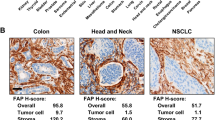Abstract.
Previous studies have shown that the herpes simplex virus type 1 thymidine kinase gene (HSV1-tk), in combination with appropriate radiolabelled substrates (e.g. [I*]-2’-fluoro-2’-deoxy-5-iodo-1-β-d-arabinofuranosyluracil; I*-FIAU, where the asterisk indicates that any of the various radioactive iodine isotopes can be used), can be used as a reporter gene forin vivo monitoring of gene transfer and expression. The aim of our study was to examine the early kinetics of I*-FIAU and the possibility of utilising iodine-123-labelled FIAU for imaging of gene expression. CMS-5 fibrosarcoma cells were transduced in vitrowith the retroviral vector STK containing the HSV1-tk gene. BALB/c mice were inoculated subcutaneously with HSV1-tk(+) and tk(-) cells into both flanks. FAU (2’-fluoro-2’-deoxy-1-β-d-arabinofuranosyluracil was radioiodinated (123I, 125I) using the iodogen method. High-performance liquid chromatography purification resulted in high specific activity and radiochemical purity for both tracers ([123I]FIAU and [125I]FIAU). Biodistribution studies and gamma camera imaging were performed at 0.5, 1, 2 and 4 h p.i. In addition, the genomic DNA of the tumours was isolated for measurement of the activity accumulation resulting from the [125I]FIAU incorporation. Biodistribution studies 0.5 h p.i. showed tumour/blood and tumour/muscle ratios of 3.8 and 7.2, respectively, for the HSV1-tk(+) tumours, and 0.6 and 1.2, respectively, for negative control tumours. Fast renal elimination of the tracer from the body resulted in rapidly increasing tumour/blood and tumour/muscle ratios which reached values of 32 and 88 at 4 h p.i., respectively. Tracer clearance from blood was bi-exponential, with an initial half-life of 0.6 h followed by a half-life of 4.6 h. The tracer half-life in herpes simplex viral thymidine kinase-expressing tumours was 35.7 h. The highest activity accumulation (20.3%±5.7% ID/g) in HSV1-tk(+) tumours was observed 1 h p.i. At that time, about 46% of the total activity found in HSV1-tk(+) tumours was incorporated into genomic DNA. Planar gamma camera imaging showed a distinct tracer accumulation as early as 0.5 h p.i., with an increase in contrast over time. These results suggest that sufficient tumour/background ratios for in vivo imaging of HSV1-tk expression with [123I]FIAU are reached as early as 1 h p.i.
Similar content being viewed by others
Author information
Authors and Affiliations
Additional information
Received 17 July and in revised form 12 November 1999
Rights and permissions
About this article
Cite this article
Haubner, R., Avril, N., Hantzopoulos, P. et al. In vivo imaging of herpes simplex virus type 1 thymidine kinase gene expression: early kinetics of radiolabelled FIAU. Eur J Nucl Med 27, 283–291 (2000). https://doi.org/10.1007/s002590050035
Issue Date:
DOI: https://doi.org/10.1007/s002590050035




